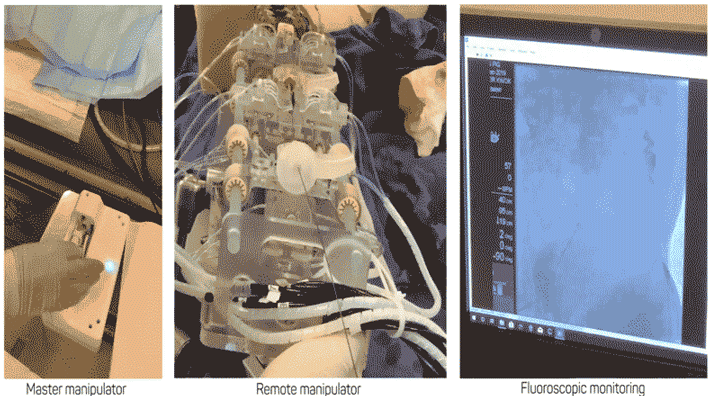Endovascular interventions are surgical procedures that can benefit from the application of robotic assistance. Endovascular techniques are widely used for the treatment of cardiovascular disease – the most common cause of death in the world. Catheters and guidewires are used to perform various tasks by navigating the vasculature to a desired anatomical target. Robotic assistance and image-guided intervention are increasingly used for improving endovascular procedures with enhanced navigation dexterity and accuracy. However, most platforms developed in the past decade still present inherent limitations in terms of altered clinical workflow, counterintuitive human-robot interaction, and a lack of versatility.
We have created a versatile, highly integrated platform for robot-assisted endovascular intervention – named as CathBot – aimed at addressing such limitations. In this study we demonstrate its clinical usability through in-vivo animal trials.
Validation studies with CathBot were conducted by an experienced vascular surgeon in four in-vivo porcine models involving the cannulation and balloon angioplasty of five target arteries. The goal is to demonstrate the feasibility of CathBot assessing its safety and clinical usability by comparison with standard manual procedures.
The procedures were successful for all target vessels in both robotic (R=2) and manual (M=2) procedures. The surgeon cannulated all arteries and deployed/inflated the angioplasty balloon with a 100% success rate using CathBot. Post-mortem histopathological assessment demonstrated a reduction in the incidence and severity of vessel trauma with robotic navigation versus manual manipulation. Structural injuries and morphologic/architectural disruption were relatively minor when the robot was used, especially regarding the incidence and/or severity of change, and also the presence of subendothelial vessel damage.
This study demonstrates the feasibility and safety of our robotic platform on porcine models, paving the way for clinical translation. Data confirms that it can resolve challenges of precise endovascular navigation, surgical workflow integration, and safety, as demonstrated by successful in-vivo trials.

